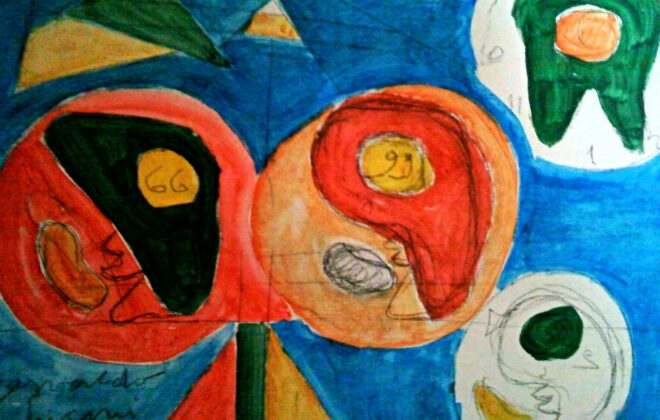Guttuso: the strength of things

 Marina Mesina , Francesco Carelli – University of Milan
Marina Mesina , Francesco Carelli – University of Milan
The exhibition “Guttuso. The strength of things” (in Pavia, Italy, Stable of Visconti Castle) not only displays works and memories of the artist’s life, but also reconstructs by images and chronicles the cultural context and places where the works were created.
Beside photos, the objects used by Renato Guttuso , then by him reproduced in his paintings, become “things”, preserving and conveying the artist’s emotions beyond their cold mere function, becoming the thread through which we can read the painter’s emotional spectrum and his overflowing personality.
Guttuso’s still life are fundamental in his artistic production and a point of reference for his generation artists, and were obsessively examined, becoming undisputed protagonists. In this exhibition you can see about 50 paintings, made from 1931 to 1986 , mainly still life, and also a wrecking yard (1978) and an auto portrait (1975).
“The meaning of thing is wider than the one of object because it includes also people or ideals and, generally, everything we are interested in or care for (or may be discussed in public, because affects the common good, from which also individuals’ good depends, in conflicting way (…….) . Objects are invested with affection, concepts and symbols projected by individuals, society and history, and become things , different from merchandise that are just for use and exchange (…….). We invest affectively and intellectually objects, giving them sense and sentimental quality, we wrap them round casket of desire or repugnant casing, frame them in relation systems, insert them in tales we can reproduce, about us and others”
And Renato Guttuso ,painting those things , is able to make us feel the “aura” and the strength they acquired.
Guttuso wrote “ I’ve painted many wrecking yards. I ‘ve painted , I mean, the car as a consumption symbol of a society that constantly needs to destroy in order to buy again “.
In a painter’s studio, objects pile up: they are meaningful symbols and these meanings can change; it depends on how the painter takes them.
Guttuso moved from a studio to another many times in his life, and his studios, particularly after 1937 when he settled for good in Rome, were for many artists, intellectuals, friends, a place where meet, paint, discuss of art and politics, and find hospitality and also refuge. And there it was possible to meet Alberto Moravia, Elsa Morante, Eugenio Montale, Luchino Visconti and many others…
Alberto Moravia wrote about Guttuso’s studio “ …there is a little table with lots of tubes and brushes and bowls and flasks; there are some chairs, as those we can see in the churches , made of raw wood and yellow straw; there are many canvas, already finished or to be painted, leaning against the walls; there is also, since Guttuso lives where he works , a bed , or better saying, a couch…”.
And Guttuso said once : “The place where one works is not planned, it’s combined and composed by itself. It’s always as if you had just moved in . I’ve never arranged objects to paint them. I’ve always painted things that were around me. I am related to things, which I live with. It’s a simple and direct connection. I try to report that when I make a picture. Objects alone promote themselves. They elect themselves as favourites. I almost suffer , if one of them disappears. Anyway, the more you have, the better you live, and you feel protected by them in the thick of trench. I always end up working in two square meters. If there are not big paintings to be done, but in this case they are the one in charge.
“ Allegory is nothing new in my painting…Even dream, fable, the analysis of feelings can have a figurative certainty if they’ve expressed – at least as I concern – through the representation of concrete “ things 2 , objects, human beings, nature without tricks or formalistic pretense..!
Reality starts when an artist put himself in front of the world, in front of the object, when the object appears to the artist, when the artist crashes into the object in order to get to know it.
True harmony , making of imagination and spirit, does not rely only in acting, as a matter of principle, being coherent externally, but it exists in the emotional strength with which everything is represented.
Painting means being inspired by what you see and think, by what you figure out. It may be a sunset, a tree, old shoes or a painting.
We believe in painting as a way to express – using lines and shades – the meaning of things. Each fact, each object, each form means something and this meaning is in the inflections, levels, modulations, form shades and space position. The painter must understand this meaning, free it from accidents and express it with simplicity. Painting, as any decisive question, must be looked right in its face, it is not possible to hang around it with more or less lovely manners. We must enter the heart of painting in order to understand its means.
“ If I couldn’t see things every time as the first one, it would mean that I have nothing more to say. It would mean that I am done. Finished. I don’t feel that I’m through yet, life still surprises, excites, thrills me. I try to understand it. We never understand the world once and for all; we do it as we go along.


